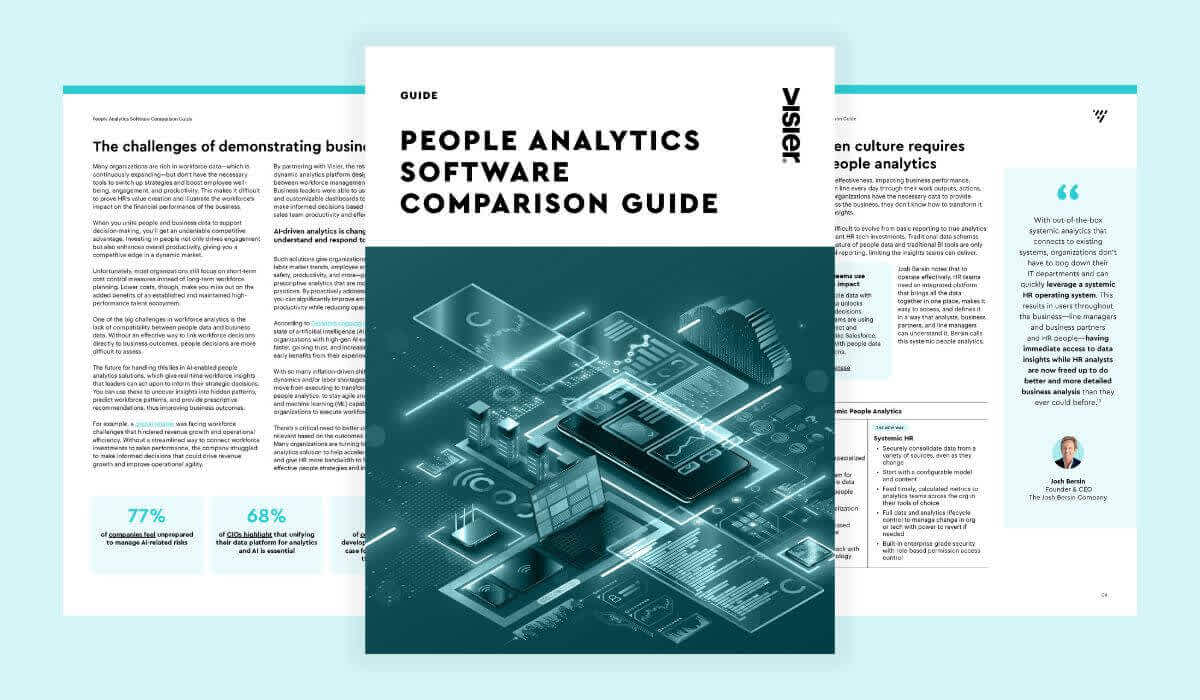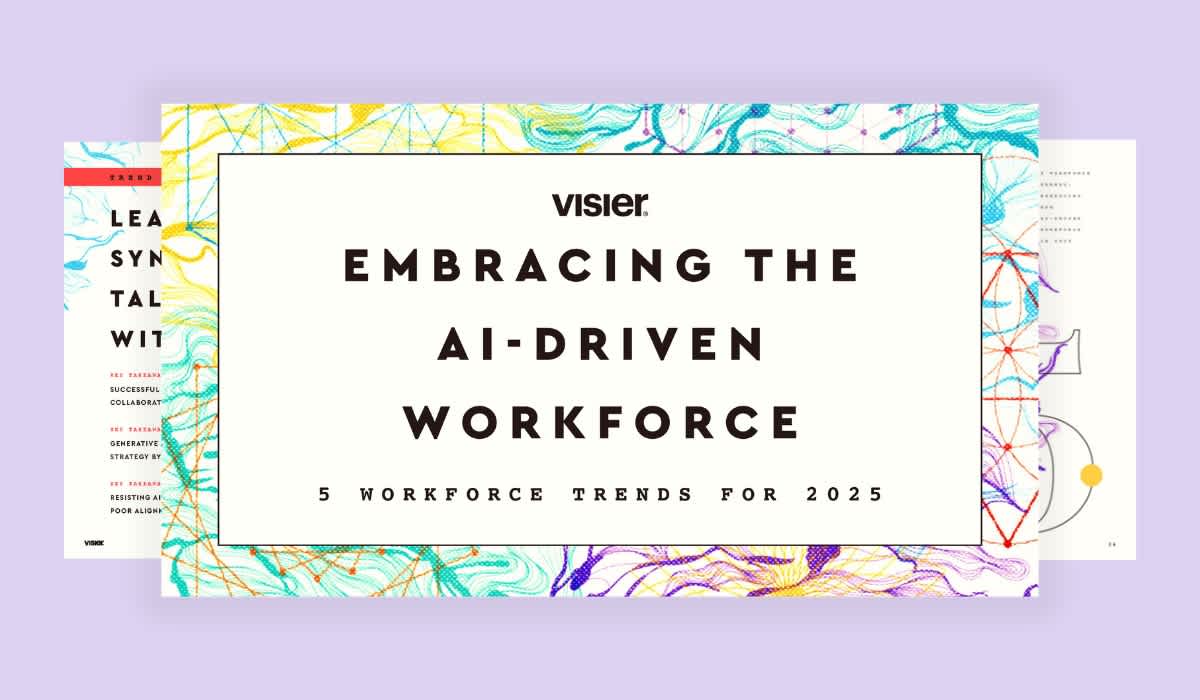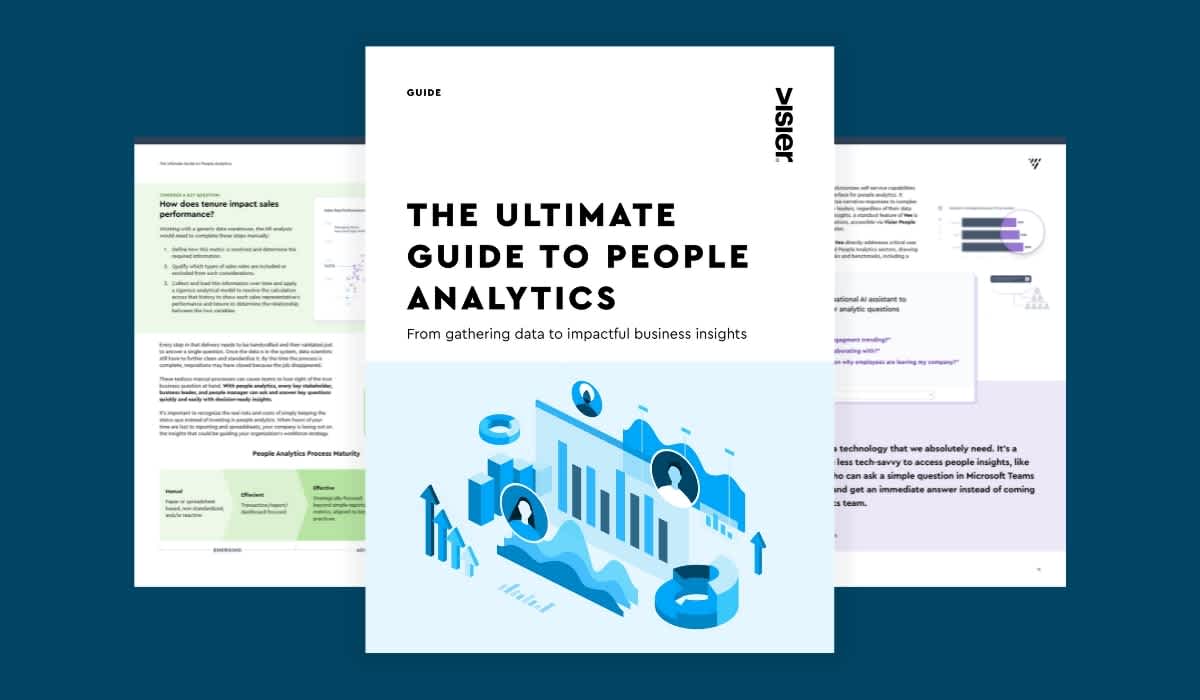People Analytics: Turn Workforce Data into Actionable Insights
What is people analytics? Learn how you can use people analytics today for various use cases like hiring, retention, diversity, and performance.

Organizations use people analytics to turn raw data into meaningful insights that improve the ways they make decisions and grow the business.
Forget gut feeling for this though. People analytics is about facts, figures, fun graphs, and plenty of “aha” moments.
People analytics platforms pull data from many business sources into one place and show the data as intuitive charts, graphs, and questions.
People analytics platforms with AI capabilities are now a must-have for every organization. Let’s take a deeper dive.
Defining people analytics
People analytics is the practice of collecting and transforming HR data and organizational data into actionable insights that improve the way you do business. You'll also see people analytics called HR analytics or workforce analytics. They’re the same thing.
The term “analytics” is often used interchangeably with other terms like “reports” and “business intelligence,” but these aren't the same thing.
A Deloitte and Visier survey of 500 business leaders revealed that leaders had low confidence in addressing some of their most pervasive, everyday business and people topics. However, with better access to people data, 70% of executives say they could make better decisions, faster.
Core metrics: Turnover, engagement, productivity
Numbers matter most? Let’s see how this plays out with a couple of people analytics metrics.
Turnover rate
Who’s leaving? When? Why?
High turnover? Trouble.
Low turnover? You must be doing something right, or maybe your people are just way too comfy.
Example and expectations: Every March, a retail chain sees its sales team turnover skyrocket. Turns out, that was bonus time. To fight it, they cranked up mid-year incentives and churn fell by 20%.
Employee engagement
Track engagement to see if people are happy or bored out of their minds.
Collect data via surveys or eNPS scores (Employee Net Promoter Score) to see how your team responds to a question like “Would you recommend us to a friend?”.
Pay attention to pulse surveys, meeting attendance, and who’s talking or not.
Example and expectations: A software company that spots a small drop in team morale via quarterly anonymous surveys after remote work-induced isolation. They can then hold team meetups and use these strategically to increase engagement scores.
People productivity
Measure performance ratings to see if teams are getting stuff done or are stuck in endless meetings. To do this, start by tracking project completion rates to spot positive/negative trends.
Example and expectations: AI helps you spot hidden productivity bottlenecks. A startup, for instance, can find recurring delay patterns due to too many approval steps in its project tool. Approvals should then be cut short, leading to shorter ship days and happier customers.

Technology platforms and data sources
What if you could see your entire workforce, crystal clear, with all the details of who's leaving, who's feeling fine, and other similar challenges? Visier pulls from your messy HR data and smushes it into a readout of the most important metrics and moments.
Visier takes data from your existing tech stack (e.g. payroll, HRIS, engagement systems), joining it together to give you actual answers to your queries, not just data bits.
Sample: Turnover up this quarter? See which teams or roles are struggling and why with Visier. Worried about engagement dropping? Visier identifies the very first disengagement signals so you can act on them before they escalate.
Want to hire better with predictive acquisition? Visier uses AI to search your history, tag what's valuable, and predict top candidates. This means you can screen candidates faster, go through more providers in less time, and ditch human bias.
Kong’s people analytics revealed something unexpected: applicants who applied directly through their system had a striking 85% retention rate. Kong is now focusing efforts on targeting, engaging, and fast-tracking these direct applicants to boost hiring efficiency.
Here comes the AI part.
Enter Vee, your digital HR assistant that gives you answers to data-related questions in plain English.

Ask Vee any question about your workforce
Using people analytics insights for various scenarios
Most companies handle huge volumes of workforce data, but they make the most of it by turning those numbers into actionable strategies. In particular, people analytics can impact:
Hiring
Use existing people analytics insights to tell where your best hires come from. These patterns let you focus your recruitment efforts where they matter most.
AI technology takes this to a whole new level as you can sort through thousands of resumes quickly with minimized bias.
Providence used Visier’s AI-powered people analytics to significantly improve its time-to-hire and overall healthcare hiring strategies in a very tight labor market.
By centralizing people and business data within Visier, they gained a complete view of their workforce and accurate vacancy forecasting. This empowered their leaders to proactively hire the right talent at the right time as they successfully onboarded over 2,000 caregivers proactively, avoiding costly shortages.

Retention
By segment, department, or location, people analytics identifies where the biggest risks of retention are.
For Enbridge, Visier transformed the way they used machine learning, going from manual refreshes once a year to real-time analyses with self-service access to refreshed data whenever needed. This gave the Enbridge team a complete picture of why employees left the organization, improving decision-making and helping them reach their diversity goals.
Diversity and inclusion
People analytics also helps you promote diversity, equity, and inclusion (DEI) initiatives. Consider setting targets for diversity of leadership and teams after identifying gaps by visualizing trends in representation.
By using methods like natural language processing (NLP) to scan job advertisements for instances of gender bias or subtle discrimination, AI provides an extra dimension to DEI efforts around the globe. Interactive dashboards help leaders follow how they measure up to DEI goals in real time, turning what often is an annual report into part of their daily routine.
Performance
Performance reviews, project completion rates, and ongoing feedback are just some of the inputs that people analytics platforms pull together.
Machine learning (ML) models can come in here to indicate which employees are a fit for taking on more responsibility. Plus, you can use ML models to identify those most in need of skill development and recommend ideal career paths based on prior success rates.
Building a people analytics team
There are lots of ways to be smart about how you run people, but more so than the R&D side of a social experiment, this is a team sport.
The engine driving it all? A team leader who's in charge of organizing projects and ensuring projects are aligned with your strategic business priorities.
Analysts then come in to investigate trends, visualize outcomes, and deploy numbers into operating action. Data engineers are the unsung heroes who keep things working under the hood, ensuring technical and data quality.
HR business partners are equally valuable when it comes to turning data findings into action plans for the workforce. They're in charge of collaborating with all teams to establish baseline goals and solidify buy-in.
Tip: As your people analytics function matures, you can take the team beyond basic reporting and begin to add AI experts.
The best teams go deep into business questions, never take things at face value, and craft “stories” that resonate with decision-makers.
Start by ensuring strong partnership options with both HR and IT. Give these folks the data points your “data champions” in all lines of business will need. Upskill support so they can all keep up with changing analytics and AI capabilities.
After all, even small teams will be able to use platforms like Visier to present clear data, bring data into one place with automated data pipelines, and analyze the "so what" with rich AI-driven recommendations.
Scaling and maturity: Vision to organization-wide impact
Maturity is all about moving from “what happened” to “what's next” so you can predict turnover, identify and close skills gaps before they become a problem, or find correlations with broader business metrics.
This is why the people analytics journey isn’t always smooth. You'll bump into messy data sets, confidentiality fears, and even people hesitating to go for more innovative people analytics solutions. The fix? Talk to your leaders and teams by presenting your data via storytelling to earn trust and quick wins.
When successfully used, people analytics supports hiring, retention, diversity, and performance at every level. This is what strengthens your workforce strategy, making it more flexible and ready to adapt to new business objectives.
Don't forget AI though as a solution to accelerate analysis, automate routine tasks, and help you accomplish things that were previously too difficult.
And remember: People analytics is not only about the technology, but also involves building a culture around trust and commitment. This is the only thing that will take your insights to action.

FAQs
What is people analytics?
People analytics is the collection and transformation of HR data and organizational data into actionable insights that improve critical talent and business outcomes.
Which HR metrics matter most in people analytics?
HR metrics such as turnover rates, engagement scores, and productivity measurement provide insight into employee retention, satisfaction, and who's delivering tangible results. The people analytics metrics should be in line with your workforce development and strategic business goals.
How can organizations start using people analytics?
Organizations can use people analytics tools like Visier to pull from common challenges they have (such as retaining high talent/talent retention and slow hiring/long time to fill a position) and identify key employee data aspects. They can then work with the initial insights to find quick wins and relay them to their leadership.
What challenges do mature teams face?
Mature people analytics teams face complex challenges, such as messy or incompatible data, privacy and security issues, and equitable buy-in from the organization's management. As teams grow, building out robust approaches to data governance and encouraging an analytics-friendly culture become vital steps in overcoming these challenges.
How do people analytics and HR intersect?
People analytics meets HR every step of the way for turning data from the workforce into strategy around hiring, retention, learning, and diversity. With analytics woven into traditional HR processes, you can go beyond mere data administration to developing data points that inform decisions around how you develop programs, anticipate issues, and drive success.


